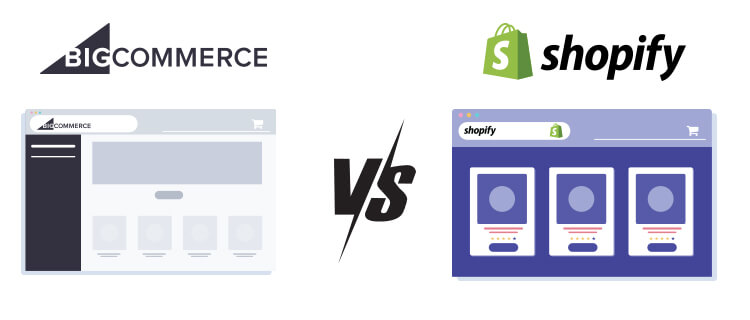
The eCommerce ecosystem is growing at an accelerated rate. Only those that can keep up with the ever-changing trends and needs will prosper. And the only way to capitalize on various ripe opportunities is through analyzing the changing customer behavior through various data and statistics.
Whether you own an eCommerce store or plan on starting one, we have a good mix list of actionable eCommerce statistics for you.
eCommerce Platforms Statistics
1. Shopify
Shopify has been simplifying the process of setting up an eCommerce store from scratch since 2004. It offers a reliable hosted platform with built-in CDN, unlimited bandwidth, and easy payment handling and much more with all subscription plans. Getting started with Shopify is as easy as setting up your account, selecting a theme, and adding products.
Here are some eye-opening statistics about Shopify:
- Shopify is the second most popular eCommerce platform on the planet, with almost 19 percent market share. (Builtwith)
- 1.5 Million Websites are powered by Shopify. (Builtwith)
- Shopify recorded $5.1+ Billion in Worldwide Sales over Black Friday/Cyber Monday Weekend in 2020 (Shopify)
- Shopify is highly popular in United States, followed by United Kingdom and Australia (Builtwith)
- Lifestyle, Food & Drink, and Sports are the top 3 Industry Verticals where Shopify is used. (similarweb)
- Shopify buyers purchase 3.8 times on average from the same store (Shopify)
- The average Shopify conversion rate is 3.08%, which is quite a prominent figure for the eCommerce industry (Magecom)
- Over 80% of merchants on Shopify sell physical goods exclusively (Shopify)
- Shopify stores have seen almost 3x as much growth as the overall e-commerce market lately. (Statista)
- Well known brands using Shopify Includes Bullet Proof, Heinz, BBC, Red Bull, Gymshark, Rebecca Minkoff Skinnydip, Kyle Cosmetics and many more.
Discover here: “How to Increase eCommerce Sales“.
2. Magento
Magento offers a powerful and open-source eCommerce platform to build fully customized stores.
Following are some Magento facts and figures worth noting:
- Magento is the third most popular eCommerce platform on the planet, with almost 10 percent market share. (Builtwith)
- Approx 200,000 websites are powered by Magento. (Builtwith)
- Magento is highly popular in United States, followed by United Kingdom and Germany (Builtwith)
- Lifestyle, Home & Garden, and Computer Electronics are the top 3 Industry Verticals where Magento is used. (Similar Web)
- Magento oversees nearly $100 billion in transactions per year. (Magento.com)
- Vendors selling over Magento grow at a 3x rate above the average. (Magento.com)
- Top names like Ford, Omega Watches, Asus, HP, Christian Louboutin, and Bulgari use Magento.
3. WooCommerce
WooCommerce is one of the most popular eCommerce platforms. It is, in fact, a plugin that converts a WordPress website into a fully-functional eCommerce counterpart. WordPress users can seamlessly adapt to the WooCommerce environment as the admin dashboard and a lot of other functionalities remain the same.
Following are some WooCommerce facts and figures worth noting:
- WooCommerce is the most popular eCommerce platform on the planet, with almost 29 percent of the market share. (Builtwith)
- 2.6 Million Websites are powered by WooCommerce. (Builtwith)
- WooCommerce is highly popular in United States, followed by United Kingdom and Australia (Builtwith)
- Computer & Electronics, Lifestyle, and Food & Drink are the top 3 Industry Verticals where WooCommerce is used. (Similar Web)
- Well known brands using WooCommerce are All Blacks, Orange Guitar Amps, Porter and York, Henry J Socks, Sodhasi, Bluestar Coffee, and many more.
Email Marketing Statistics
Among all the marketing and outreach techniques, email marketing continues to reign supreme in affordability and efficacy.
From building long-term relationships with your client to notifying them about flash sales and deals, email marketing can make it happen.
Following are some Email Marketing Statistics worth noting:
- 61% of online buyers would prefer to be contacted via emails. (Statista)
- A staggering 42% of Americans sign up for marketing emails to receive updates on special discounts and offers.
- While marketing emails have an average open rate of 21.33%, triggered emails, such as abandoned shopping cart email or birthday emails, receive a higher response. (Mailchimp)
- An abandoned cart email caused 23% of shoppers to return and complete the order. (Omnisend)
- Sending three cart abandon emails increased orders by 69% in comparison to a single cart abandon email. (Omnisend)
- Amongst the various eCommerce industries, the fashion sector witnesses the highest response, with an average open rate of 43.15% with a CTR of 31.34%. (Salescycle)
- Almost 50% of SMBs utilize marketing automation software to execute drip email marketing campaigns. (Statista)
Social Commerce Statistics
Social media is gradually opening up more avenues for eCommerce stores to connect with their potential customers. In addition to boosting brand awareness and expanding outreach, social media platforms are also acting as conduits to diversify sales channels.
Following are some Social Commerce Statistics worth noting:
- 40% of eCommerce store owners deploy social media channels to generate or increase sales. (Absolunet)
- About 87% of eCommerce shoppers admit that social media plays a crucial role in their purchase decisions. (Absolunet)
- 30% of shoppers are willing to make purchases directly over social media platforms, such as Facebook, Instagram, Pinterest, Twitter, or Snapchat. (Absolunet)
- Social media-driven referral traffic has increased by over 100% in the last two years alone! (Smashing Social Commerce Stats)
- A whopping 70% of prospective buyers look up the products on Facebook and Instagram before making a purchase. (Smashing Social Commerce Stats)
Video Marketing Statistics
Video marketing has emerged as a highly effective end-to-end strategy that could help at every stage – from lead generation to post-sales service. Furthermore, smartphones can now capture high-quality video content, negating the need for expensive equipment and massive budgets for video production. As a result, regardless of their domains, eCommerce industries can tap into the advantages offered by video marketing.
Following are some Video Marketing Statistics worth noting:
- 93% of businesses claim to acquire a new customer through video marketing strategies deployed over social media. (Smallbiztrends)
- According to Google, over 55% of buyers refer to online videos, even while purchasing from physical stores.
- 58% of buyers perceive companies with product videos to be more worthy of their trust and money. (Hubspot)
- 33% of users agree that videos are the first channel of introduction to any product. (wyzowl)
- 69% of people admit that product demonstration videos play a crucial role in aiding purchase decisions. (wyzowl)
- 71% of users believe that videos are more effective in explaining the working of any product. (Hubspot)
Conversion Rate Optimization (CRO) Statistics
While the concept of CRO is relatively new, it has started to gain traction as it addresses the primary business pain point – conversion. A higher conversion rate translates to greater revenue, which is essentially what any business wants!
Following are some Conversion Rate Optimization Statistics worth noting:
- Amongst all eCommerce categories, the F&B industry enjoys the highest average conversion rate of 4.95%, while sporting goods register the lowest average conversion rate at 2.35%.
- Long or complicated checkout processes have resulted in nearly 21% of buyers abandoning their shopping carts. (Baymard)
- A buyer reads an average of ten customer reviews before finalizing whether they plan on making the purchase or otherwise. (OptInMonster)
- 90% of Americans attribute free shipping as the greatest incentive for shopping online more. (Invespcro)
- 75% of buyers would be more eager to buy from a brand that offers same-day delivery. (Dropoff)
- 34% of buyers will give up on a purchase if the eCommerce store does not offer a guest checkout option. (OptInMonster)
- Incorporating live chat into your eCommerce store increases conversion rates by 20%, increasing the ROI by 305%. (Business2Community)
Conclusion
It may seem daunting, but keeping up with the latest eCommerce trends will reward you in proportion to the effort. It lets you stay up to speed and adapt to any disruptions that may rock the eCommerce world. Use the statistics cited above to stay relevant and ensure that your store is always a step ahead of the rest!


